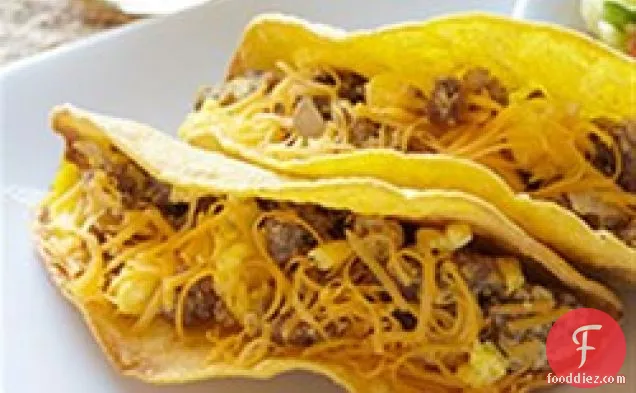Ground Bison Breakfast Tacos with Pineapple Salsa

You can never have too many main course recipes, so give Ground Bison Breakfast Tacos with Pineapple Salsan a try. Watching your figure? This gluten free recipe has 436 calories, 27g of protein, and 23g of fat per serving. This recipe serves 6. From preparation to the plate, this recipe takes roughly 25 minutes. A mixture of cayenne pepper, onion, pineapple, and a handful of other ingredients are all it takes to make this recipe so scrumptious. To use up the pineapple you could follow this main course with the Pineapple Cupcakes as a dessert. This recipe is typical of Mexican cuisine.
Instructions
1
Cook ground bison and onion over medium heat in a large skillet until ground bison is brown and onion is tender.
Ingredients you will need![Ground Bison]() Ground Bison
Ground Bison![Onion]() Onion
Onion
Equipment you will use![Frying Pan]() Frying Pan
Frying Pan
2
Drain off fat. Stir in cumin, salt, coriander, cayenne pepper, and water. Cook and stir for 2 minutes.
Ingredients you will need![Cayenne Pepper]() Cayenne Pepper
Cayenne Pepper![Coriander]() Coriander
Coriander![Cumin]() Cumin
Cumin![Water]() Water
Water![Salt]() Salt
Salt
3
Whisk eggs and milk in a medium bowl.
Ingredients you will need![Egg]() Egg
Egg![Milk]() Milk
Milk
Equipment you will use![Whisk]() Whisk
Whisk![Bowl]() Bowl
Bowl
4
Add to ground bison mixture in skillet. As the mixture sets, run a spatula around the edge of the skillet, lifting egg mixture so uncooked portion flows underneath. Continue cooking and lifting for 2 minutes or until egg mixture is almost set.
Ingredients you will need![Ground Bison]() Ground Bison
Ground Bison![Egg]() Egg
Egg
Equipment you will use![Frying Pan]() Frying Pan
Frying Pan![Spatula]() Spatula
Spatula
Ingredients
0teaspoons![cayenne pepper, or more to taste]() cayenne pepper, or more to taste1
cayenne pepper, or more to taste1![fresh jalapeno chile pepper, seeded and finely chopped (optional)]() fresh jalapeno chile pepper, seeded and finely chopped (optional)126-inchs
fresh jalapeno chile pepper, seeded and finely chopped (optional)126-inchs![corn taco shells or 6-inch corn tortillas, heated according to package directions]() corn taco shells or 6-inch corn tortillas, heated according to package directions6
corn taco shells or 6-inch corn tortillas, heated according to package directions6![eggs]() eggs2Tbsps
eggs2Tbsps![chopped fresh cilantro]() chopped fresh cilantro454grams
chopped fresh cilantro454grams![ground bison]() ground bison0teaspoons
ground bison0teaspoons![ground coriander]() ground coriander1teaspoon
ground coriander1teaspoon![ground cumin]() ground cumin2Tbsps
ground cumin2Tbsps![lime juice]() lime juice59milliliters
lime juice59milliliters![milk]() milk118milliliters
milk118milliliters![chopped onion]() chopped onion237milliliters
chopped onion237milliliters![diced fresh pineapple]() diced fresh pineapple79milliliters
diced fresh pineapple79milliliters![diced red bell pepper]() diced red bell pepper59milliliters
diced red bell pepper59milliliters![chopped red onion]() chopped red onion0teaspoons
chopped red onion0teaspoons![salt]() salt177milliliters
salt177milliliters![shredded Cheddar cheese]() shredded Cheddar cheese2Tbsps
shredded Cheddar cheese2Tbsps![water]() water
water
 cayenne pepper, or more to taste1
cayenne pepper, or more to taste1 fresh jalapeno chile pepper, seeded and finely chopped (optional)126-inchs
fresh jalapeno chile pepper, seeded and finely chopped (optional)126-inchs corn taco shells or 6-inch corn tortillas, heated according to package directions6
corn taco shells or 6-inch corn tortillas, heated according to package directions6 eggs2Tbsps
eggs2Tbsps chopped fresh cilantro454grams
chopped fresh cilantro454grams ground bison0teaspoons
ground bison0teaspoons ground coriander1teaspoon
ground coriander1teaspoon ground cumin2Tbsps
ground cumin2Tbsps lime juice59milliliters
lime juice59milliliters milk118milliliters
milk118milliliters chopped onion237milliliters
chopped onion237milliliters diced fresh pineapple79milliliters
diced fresh pineapple79milliliters diced red bell pepper59milliliters
diced red bell pepper59milliliters chopped red onion0teaspoons
chopped red onion0teaspoons salt177milliliters
salt177milliliters shredded Cheddar cheese2Tbsps
shredded Cheddar cheese2Tbsps water
waterRecommended wine: Pinot Noir, Riesling, Sparkling Rose
Pinot Noir, Riesling, and Sparkling rosé are my top picks for Mexican. Acidic white wines like riesling or low-tannin reds like pinot noir can work well with Mexican dishes. Sparkling rosé is a safe pairing too. The Dragonette Cellars Sta. Rita Hills Pinot Noir with a 4.8 out of 5 star rating seems like a good match. It costs about 45 dollars per bottle.

Dragonette Cellars Sta. Rita Hills Pinot Noir
2016 was another in a string of terrific vintages in Santa Barbara. We had another early budbreak, and (unlike 2015) perfect weather during set, allowing for a strong, balanced crop. May, June and July were quite warm and ripening was fairly quick; however, an unseasonably cool August slowed the vines considerably. For the winemaker it was almost ideal, as the grapes were able to complete ripening slowly, without heat spikes, and the grapes maintained excellent acidity. Over a series of cool mornings, we picked each block at near perfect ripeness and balance. The wines appear to have great fruit character, fresh acidity and tannic structure and solid depth.DifficultyMedium
Ready In25 m.
Servings6
Health Score14
Related recipes
Cheesy Vegetable Frittata
Nutty Banana Banana Bread
Lemon Yogurt Bread
Oatmeal Cranberry Breakfast Bake
Magazine

Your Inner Chef with Taylor Swift's Top 3 Recipes from Her Beloved NYC Hangout

20 Mouthwatering Recipes You Need to Try Today!

Master the Art of Making Perfect Pancakes with This Foolproof Recipe

The Science Behind Red Wine: Its Surprising Health Benefits and Potential Risks

12 Wine Cocktails for a Sophisticated Twist

Sip, Swirl, and Celebrate: Toasting to National Wine Day on May 25th

National Drink Wine Day on February 18

Celebrating Souffle Day with Delectable Delights

Indulge in the Delightful Flavor of Oyster Soup on Its Special Day!

Celebrating World Nutella Day

Discover the Best Recipes Using Only Fresh Fruits and Vegetables

Recipes of June A Culinary Journey through Summer Flavors

A Journey into the World of Espresso Machines and the Art of Brewing

Unveiling the Must-Have Blenders of 2023

A Step-by-Step Guide to Perfectly Cooked Corn

10 Delicious Recipes That Use Beer as a Secret Ingredient

Delicious Recipes with Honey for Every Palate

Freezing Butter: Your Questions Answered

5 Creative Ways to Enjoy Avocado

A Journey Through the World of Coffee Types

Your Inner Chef with Taylor Swift's Top 3 Recipes from Her Beloved NYC Hangout

Master the Art of Making Perfect Pancakes with This Foolproof Recipe

Celebrating Souffle Day with Delectable Delights

Celebrating World Nutella Day

Top 20+ Must-Try Recipes Dominating February 2024

Vegetarian soup recipes are not just for vegetarians anymore

Decoding the Keto Food Pyramid for Optimal Weight Loss and Health

Secrets of the Food Pyramid: A Journey Through its Intriguing History

The Future of Nutritionthe New and Improved Food Pyramid




